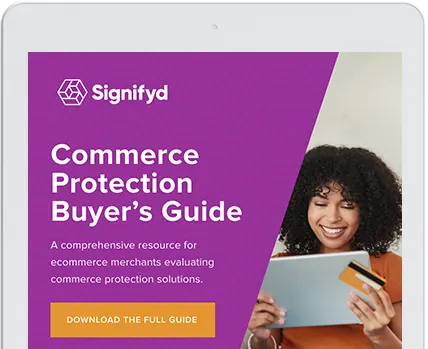It’s one of life’s ironies. You work hard to make your online business more visible and just when you’re getting some traction — the fraudsters appear.
The combination of advertising campaigns, a rising search engine ranking, and the youth of a store (and perceived inexperience with detecting fraud), make an online merchant an ideal target for fraudsters.
Let’s explore why this is the case.
When an online merchant opens an ecommerce storefront, they’re entering a vast market, one that is projected to have almost $5 trillion in U.S. sales by 2024. It’s a market dominated by large players like Amazon, Walmart ASOS and others.
In the beginning, an ecommerce business might generate sales primarily through friends and family. If they intend to grow beyond this small circle, they take steps to increase their visibility and boost traffic. They create sales and marketing strategies on variety of channels, all designed to drive customers to their site and create sales. (For example, a common strategy is using Facebook Ads to target a particular demographic, or buying keywords from Google AdWords.)
If the strategies work, the business generates an increase in traffic by customers interested in purchasing the company’s product. As a result of this increase in traffic, the company’s search engine ranking rises. (Alexa is a common tool that lists site rankings.)
But with the increased visibility comes an unwanted new type of customer no business wants, a fraudster.
If you are an online merchant evaluating commerce protection vendors, you might be interested in our free Commerce Protection Buyer’s Guide. This comprehensive guide outlines the evolution of commerce protection from fraud prevention and details the integral components of a commerce protection solution. Takeaway resources include:
- A sample RFI template to leverage in your evaluation process
- Tips on how to build a business case for a commerce protection solution
- How to evaluate ROI and understand the tools used to protect against fraud and chargebacks
- How to find the right solution for your business
What is business fraud and why am I getting hit with it now?
As an ecommerce site’s search ranking increases, the online store is simply easier to find than it was previously. For better, and for worse, the plan to grab more visitors worked, and some of the visitors aren’t good.
Fraudsters are aware of the fact that established online stores have online fraud protection measures. Typically, the larger the corporation, the more robust the security set-up, and the more experienced they are at detecting and preventing fraudulent orders.
The same usually can’t be said for new ecommerce companies, who might have little awareness of the true complexities of online fraud and what a fraudulent order looks like. This, combined with a new online merchant’s eagerness to accept orders, translates into great opportunity for fraudsters.
Larger stores expect to cancel a certain number of orders due to their riskiness and potential for fraud, but the same mindset typically isn’t there for new or smaller ecommerce merchants. Cancelling even a single order for a new company can be a distressing decision, as they’re understandably eager to grow their business. Fraudsters seek to prey on the companies who most need the cash to grow, because they recognize how desperate small companies are for business. As a result, they’re constantly looking for the next new online store to exploit.
Why do new or small online merchants fail to identify fraud?
New and smaller merchants generally have two factors working against them: a lack of fraud experience detecting fraudulent orders and a lack of resources to dedicate a full-time employee to reviewing orders.
These merchants often find themselves out of their depth when it comes to fraud, as they lack the scope of experience their larger competitors have. Indeed, the thousands of hours spent differentiating between a good order and a bad one makes a much bigger company more effective at identifying common fraudulent patterns in the future, and preventing acceptance of bad orders.
Plus, if the merchant does flag an order as possibly suspicious, they may not know how to properly investigate, and which pieces of data they should give more credence to than others. For example, without experience in order review, a new or small online merchant might simply call the customer to clarify certain order details, as they lack the knowledge that a smart fraudster is more than willing to answer a phone call.
On top of that, many online merchants simply don’t have the financial resources to dedicate staff (or hire an experienced professional) to review orders. That makes them a ripe target for continuing fraudulent attacks.
Can I stop fraud?
The only way to stop fraud on a site is to stop selling.
But, as that’s often out of the question, online merchants will have to turn to selling smarter and adapting the mindset of larger competitors. As painful as it is, expect to decline some orders. Expect that fraud will occur, and start preparing your organization to deal with it. Depending on your resources, you will have a few options, from improving order review efficiency and effectiveness in-house to using a vendor with fraud expertise to handle order review entirely.
In the world of online fraud, the best defense is a good offense. Start building your offense now.
Want to learn more about fraud protection?












